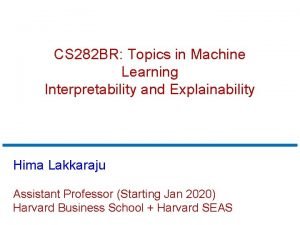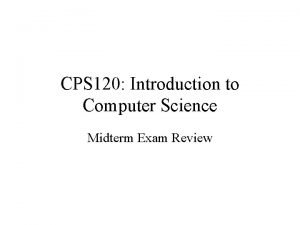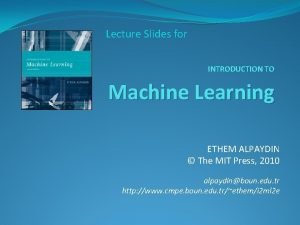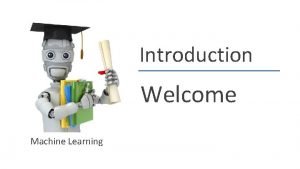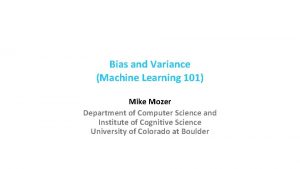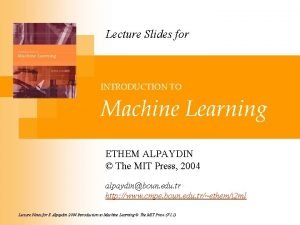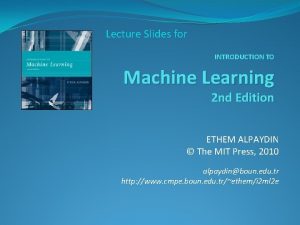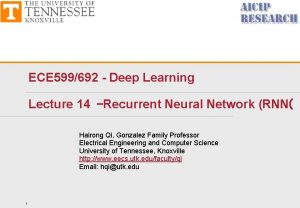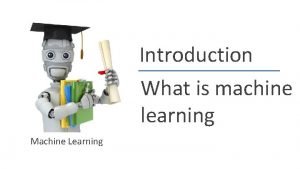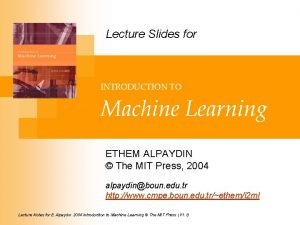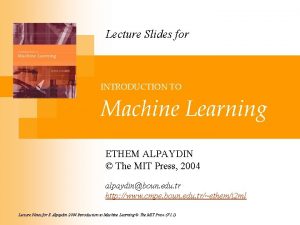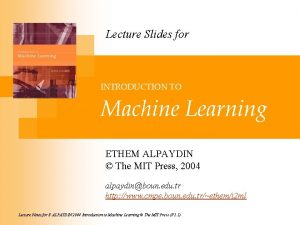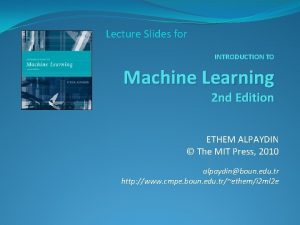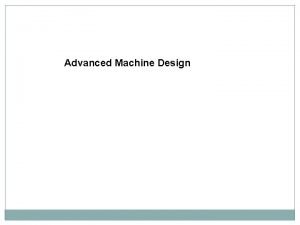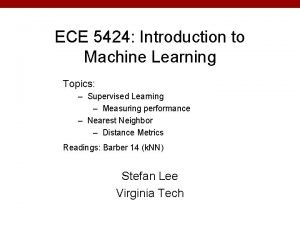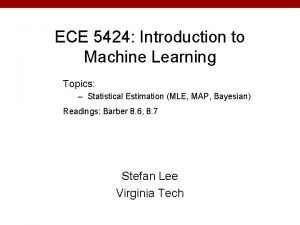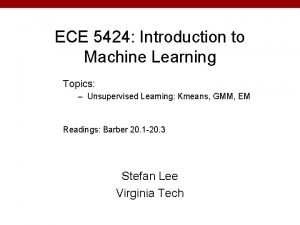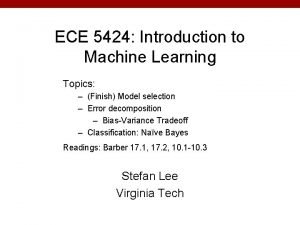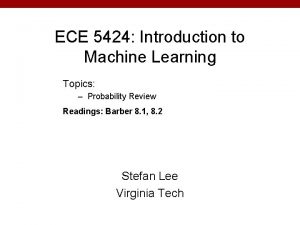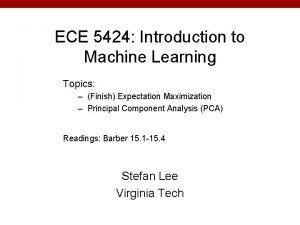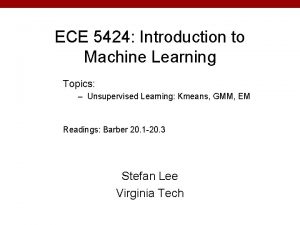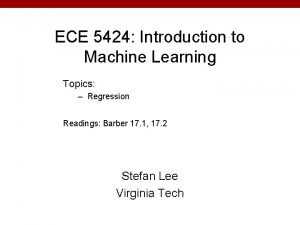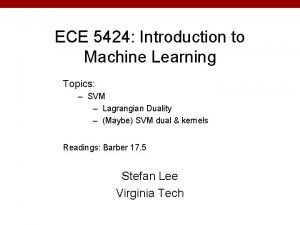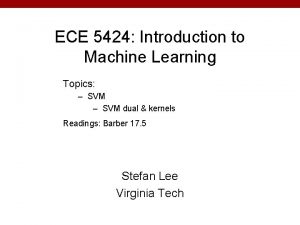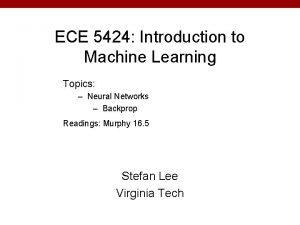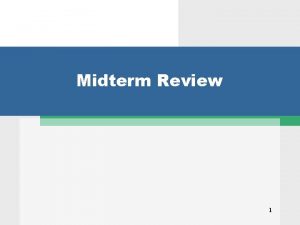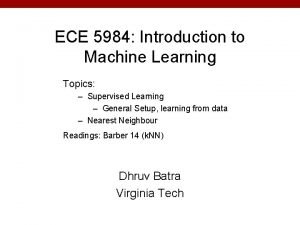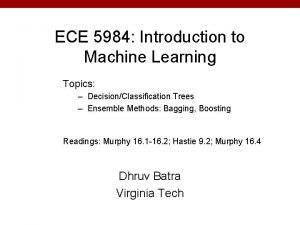ECE 5424 Introduction to Machine Learning Topics Midterm






























- Slides: 30

ECE 5424: Introduction to Machine Learning Topics: – Midterm Review Stefan Lee Virginia Tech

Format • Midterm Exam • When: October 6 th, class timing • Where: In class • Format: Pen-and-paper. • Open-book, open-notes, closed-internet. • No sharing. • What to expect: mix of • Multiple Choice or True/False questions • “Prove this statement” • “What would happen for this dataset? ” • Material • Everything from beginning to class to Tuesday’s lecture 2

How to Prepare • Find the “What You Should Know” slides in each lecture powerpoints and make sure you know those concepts • This presentation provides an overview but is not 100% complete. • Review class materials and your homeworks. • We wont ask many questions you can just look up so get a good nights rest and come prepared to think. 3

Summary of Topics Covered • K Nearest Neighbor Classifier / Regressor • Distance Functions (L 1, L 2, Mahalanobis) • Weighted k-NN & Kernel Regression • Statistical Estimation • Basic Probability • Random Variables, Bayes Rule, Chain Rule, Marginalization, Independence, Conditional Independence, Entropy, KL Divergence • Maximum Likelihood Estimation (MLE) • General MLE strategy • Bernoulli • Categorical • Normal/Gaussian • Maximum A Posteriori (MAP) • Effect of Priors • Conjugate Priors • Bernoulli * Beta = Beta • Categorical * Dirichlet = Dirichlet • Gaussian* Gaussian = Gaussian 4

Summary of Topics Covered (Cont’d) • Linear Regression • Ordinary Least Squares • Robust Least Squares and Ridge Regression • Naïve Bayes • Logistic Regression • Regularized Logistic Regression • General Machine Learning Know-how • General Train/Val/Test Strategy • Underfitting / Overfitting • Error Decomposition • Modelling, Estimation, Optimization, & Bayes • Bias / Variance Tradeoff • Model Classes • Algorithm Evaluations and Diagnostics • Loss Functions, Confusion Matrices, ROC Curves, Learning Curves, Cross Validation • Curse of Dimensionality • Generative vs. Discriminative Models 5

Summary of Topics Covered (Cont’d) • Other Important Mathematic Concepts • Vector Algebra • Basic Calculus • Convexity / Concavity • Gradient Descent / Ascent 6

Know Your Models: k. NN Classification / Regression • The Model: • Classification: Find nearest neighbors by distance metric and let them vote. • Regression: Find nearest neighbors by distance metric and average them. • Weighted Variants: • Apply weights to neighbors based on distance (weighted voting/average) • Kernel Regression / Classification • Set k to n and weight based on distance • Smoother than basic k-NN! • Problems with k-NN • Curse of dimensionality: distances in high d not very meaningful • Irrelevant features make distance != similarity and degrade performance • Slow NN search: Must remember (very large) dataset for prediction 7

Know Your Models: Linear Regression 8

Know Your Models: Naïve Bayes Classifier 9

Know Your Models: Logistic Regression Classifier 10

Know: Difference between MLE and MAP 11

Be Familiar: Distribution We Discussed 12

Know: Conjugate Priors / Effect of Priors Likelihood Prior Posterior Bernoulli Beta Categorical Dirichlet Gaussian Example: Bernoulli with a Beta Prior • Prior = Beta(2, 2) • θprior = 0. 5 • Dataset = {H} • L(θ) = θ , θMLE = 1 • Posterior = Beta(3, 2) • θMAP = (3 -1)/(3+2 -2) = 2/3 13

Know: Bayesian Inference (aka appreciating posteriors) Example: I want to estimate the chance I’ll lose money on a bet. • MLE strategy: find MLE estimate for chance of success under a Bernoulli likelihood and look at expected loss on my gambling. • This is a point estimate and requires that my MLE estimate is pretty good • Bayesian strategy: find posterior over the chance of success and compute expected loss over my beliefs of this chance • Lets us reason about the uncertainty of our estimate though the integral of the posterior might be mess… conjugate priors ensure it isn’t! 14

Skills: Be able to Compute MLE of Parameters 15

Practice: Compute MLE for Poisson Distribution 16

Skills: Be able to Compute MAP of Parameters 17

Practice: Compute Map for Poisson Distribution with Gamma Prior 18

19

Skills: Be Able to Compare and Contrast Classifiers • K Nearest Neighbors • Assumption: f(x) is locally constant • Training: N/A • Testing: Majority (or weighted) vote of k nearest neighbors • Logistic Regression • Assumption: P(Y|X=xi) = sigmoid( w. Txi) • Training: SGD based • Test: Plug x into learned P(Y | X) and take argmax over Y • Naïve Bayes • Assumption: P(X 1, . . , Xj | Y) = P(X 1 | Y)*…* P(Xj | Y) • Training: Statistical Estimation of P(X | Y) and P(Y) • Test: Plug x into P(X | Y) and find argmax P(X | Y)P(Y) 20

Practice: What classifier(s) for this data? Why? x 1 x 2 21

Practice: What classifier for this data? Why? x 1 x 2 22

Know: Error Decomposition • Approximation/Modeling Error – You approximated reality with model • Estimation Error – You learned a model with finite data • Optimization Error – You were lazy and couldn’t/didn’t optimize to completion • Bayes Error – there is a lower bound on error for all models, usually non-zero 23

Know: How Error Types Change w. r. t Other Things Modelling Estimation Optimization More Training Data Larger Model Class Bayes Reality Sucks (maybe) Reality Still Sucks How to change model class? • Same model with more/fewer features • Different model with more/fewer parameters • Different model with different assumptions (linear? Non-linear? How much data do I need? • Depends on the model. . Gaussian Naïve Bayes and Logistic regression give same result in the limit if GNB assumptions hold • GNB typically needs less data to approach this limit but if the assumptions don’t hold LR is expected to do better. 24

Know: Bias vs Variance • 25

Know: Learning Curves • Plot error as a function of training dataset size Low Variance but bad model, more data wont help Validation Error High Variance but more data will help Train Error Validation Error Train Error # Samples Trained On 26

Know: Underfitting & Overfitting • Plot error through training (for models without closed form solutions Error Validation Error Train Error Underf itting Training Iters Overfitting • Overfitting is easier with more complex models but is possible for any model • More data helps avoid overfitting as do regularizers 27

Know: Train/Val/Test and Cross Validation Train – used to learn model parameters Validation – used to tune hyper-parameters of model Test – used to estimate expected error 28

Skills: Be Able to Argue for Concavity/Convexity • Today’s readings help a great deal! • Alternative: show the Hessian matrix is positive semidefinite • Alternative: argue with properties of convexity i. e. affine functions are convex, min of convex functions are convex , sum of convex functions is convex, etc. . 29

Practice: Show if f(x) is convex 30
 Cs 282r topics in machine learning
Cs 282r topics in machine learning Introduction to computer science midterm exam
Introduction to computer science midterm exam Introduction to computer science midterm exam test
Introduction to computer science midterm exam test Concept learning task in machine learning
Concept learning task in machine learning Analytical learning in machine learning
Analytical learning in machine learning Pac learning model in machine learning
Pac learning model in machine learning Pac learning model in machine learning
Pac learning model in machine learning Inductive vs analytical learning
Inductive vs analytical learning Inductive analytical approach to learning
Inductive analytical approach to learning Instance based learning in machine learning
Instance based learning in machine learning Inductive learning machine learning
Inductive learning machine learning First order rule learning in machine learning
First order rule learning in machine learning Eager learner and lazy learner
Eager learner and lazy learner Cmu machine learning
Cmu machine learning Introduction to machine learning ethem alpaydin
Introduction to machine learning ethem alpaydin Machine learning andrew ng
Machine learning andrew ng Andrew ng introduction to machine learning
Andrew ng introduction to machine learning Mike mozer
Mike mozer Introduction to machine learning ethem alpaydin
Introduction to machine learning ethem alpaydin Machine learning introduction slides
Machine learning introduction slides Introduction to machine learning slides
Introduction to machine learning slides Introduction to azure ml
Introduction to azure ml Lstm lecture
Lstm lecture Introduction to machine learning andrew ng
Introduction to machine learning andrew ng Introduction to machine learning ethem alpaydin
Introduction to machine learning ethem alpaydin Machine learning ethem alpaydin
Machine learning ethem alpaydin Machine learning ethem
Machine learning ethem Machine learning lecture notes
Machine learning lecture notes Advanced machine and engineering
Advanced machine and engineering Cuadro comparativo de e-learning
Cuadro comparativo de e-learning Global citizenship education topics and learning objectives
Global citizenship education topics and learning objectives
